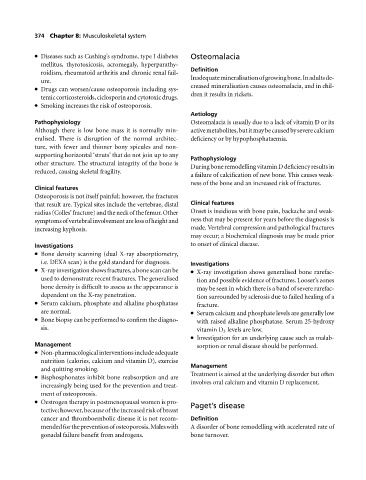Page 378 - Medicine and Surgery
P. 378
P1: KTX
BLUK007-08 BLUK007-Kendall May 12, 2005 19:48 Char Count= 0
374 Chapter 8: Musculoskeletal system
Diseases such as Cushing’s syndrome, type I diabetes Osteomalacia
mellitus, thyrotoxicosis, acromegaly, hyperparathy-
Definition
roidism, rheumatoid arthritis and chronic renal fail-
Inadequatemineralisationofgrowingbone.Inadultsde-
ure.
creased mineralisation causes osteomalacia, and in chil-
Drugs can worsen/cause osteoporosis including sys-
dren it results in rickets.
temiccorticosteroids,ciclosporinandcytotoxicdrugs.
Smoking increases the risk of osteoporosis.
Aetiology
Pathophysiology Osteomalacia is usually due to a lack of vitamin D or its
Although there is low bone mass it is normally min- activemetabolites,butitmaybecausedbyseverecalcium
eralised. There is disruption of the normal architec- deficiency or by hypophosphataemia.
ture, with fewer and thinner bony spicules and non-
supporting horizontal ‘struts’ that do not join up to any
Pathophysiology
other structure. The structural integrity of the bone is
During bone remodelling vitamin D deficiency results in
reduced, causing skeletal fragility.
a failure of calcification of new bone. This causes weak-
ness of the bone and an increased risk of fractures.
Clinical features
Osteoporosis is not itself painful; however, the fractures
that result are. Typical sites include the vertebrae, distal Clinical features
radius(Colles’fracture)andtheneckofthefemur.Other Onset is insidious with bone pain, backache and weak-
symptomsofvertebralinvolvementarelossofheightand ness that may be present for years before the diagnosis is
increasing kyphosis. made. Vertebral compression and pathological fractures
may occur; a biochemical diagnosis may be made prior
Investigations to onset of clinical disease.
Bone density scanning (dual X-ray absorptiometry,
i.e. DEXA scan) is the gold standard for diagnosis. Investigations
X-rayinvestigationshowsfractures,abonescancanbe X-ray investigation shows generalised bone rarefac-
used to demonstrate recent fractures. The generalised tion and possible evidence of fractures. Looser’s zones
bone density is difficult to assess as the appearance is may be seen in which there is a band of severe rarefac-
dependent on the X-ray penetration. tion surrounded by sclerosis due to failed healing of a
Serum calcium, phosphate and alkaline phosphatase fracture.
are normal. Serum calcium and phosphate levels are generally low
Bone biopsy can be performed to confirm the diagno- with raised alkaline phosphatase. Serum 25-hydroxy
sis. vitamin D 3 levels are low.
Investigation for an underlying cause such as malab-
Management sorption or renal disease should be performed.
Non-pharmacological interventions include adequate
nutrition (calories, calcium and vitamin D), exercise
Management
and quitting smoking.
Treatment is aimed at the underlying disorder but often
Bisphosphonates inhibit bone reabsorption and are
involves oral calcium and vitamin D replacement.
increasingly being used for the prevention and treat-
ment of osteoporosis.
Oestrogen therapy in postmenopausal women is pro- Paget’s disease
tective;however,becauseoftheincreasedriskofbreast
cancer and thromboembolic disease it is not recom- Definition
mendedforthepreventionofosteoporosis.Maleswith A disorder of bone remodelling with accelerated rate of
gonadal failure benefit from androgens. bone turnover.

